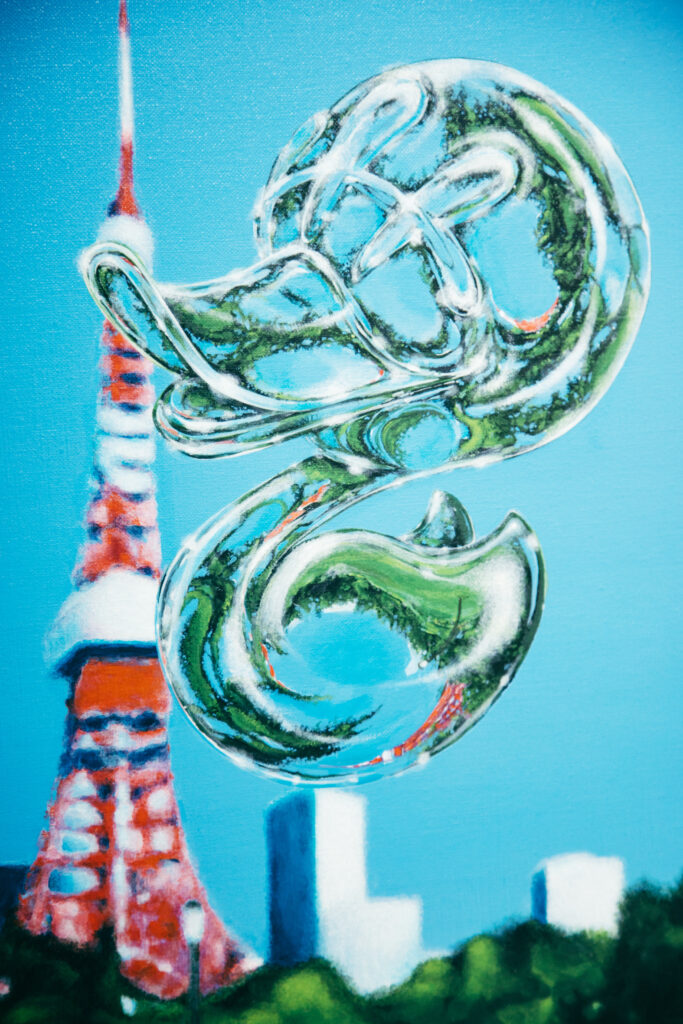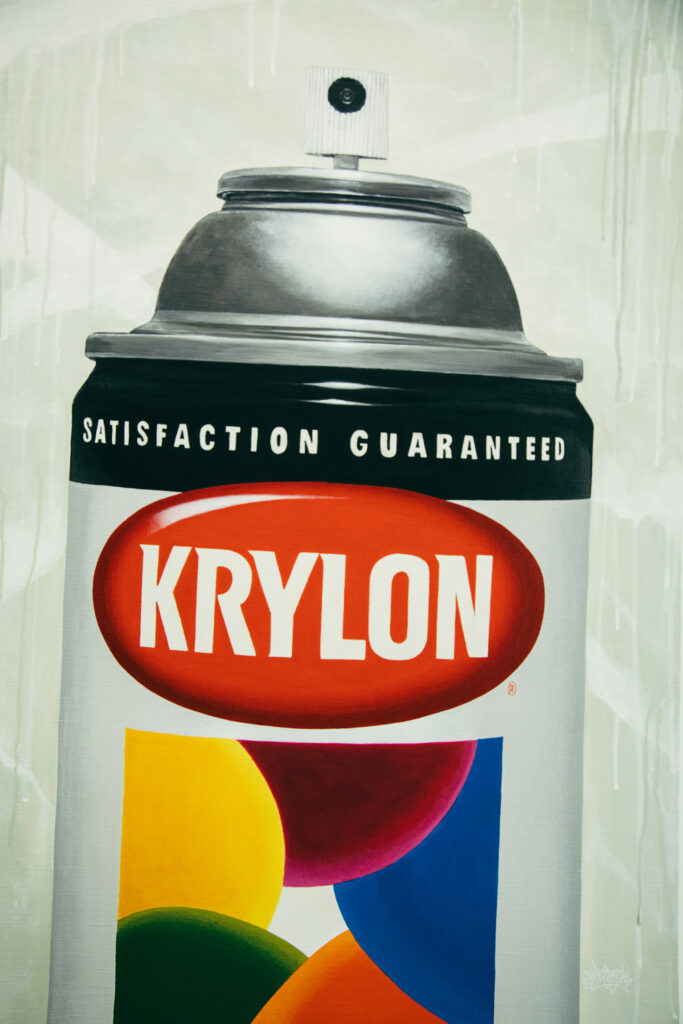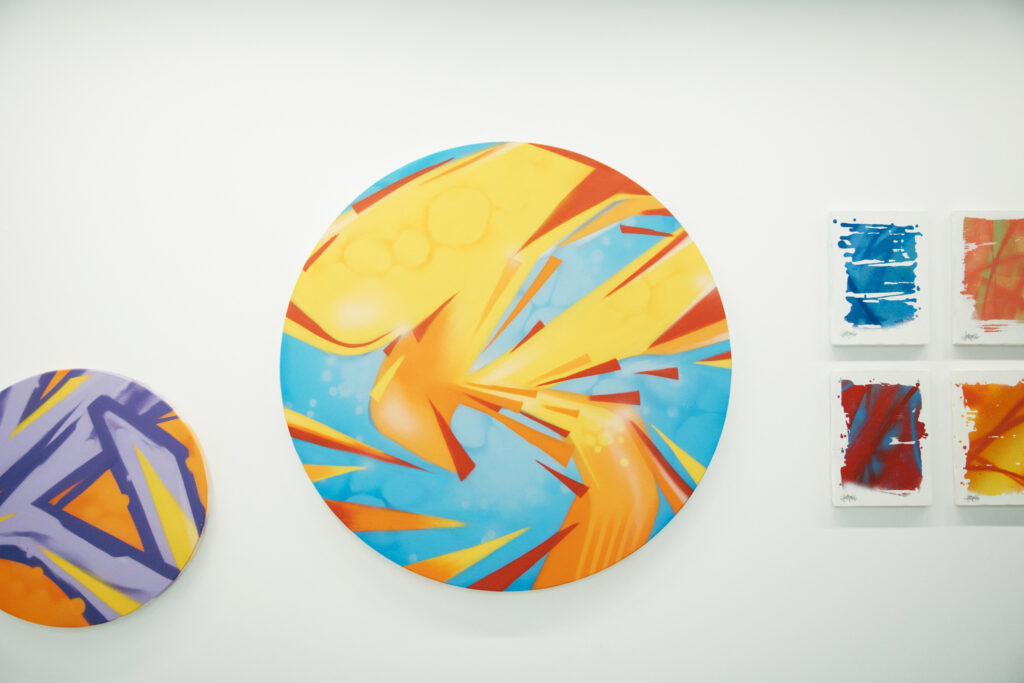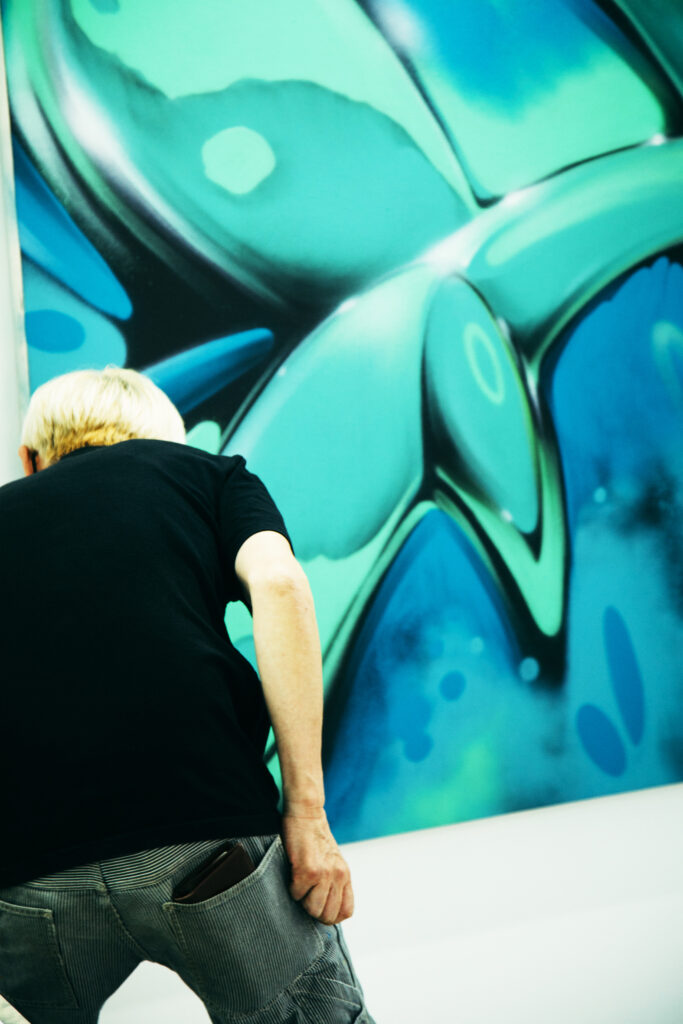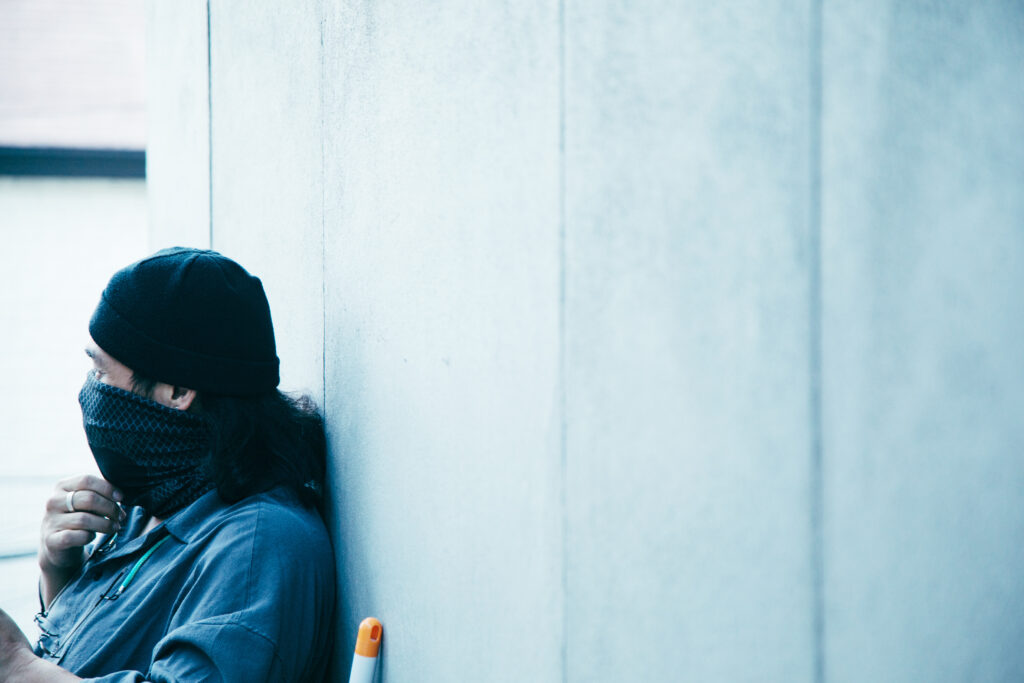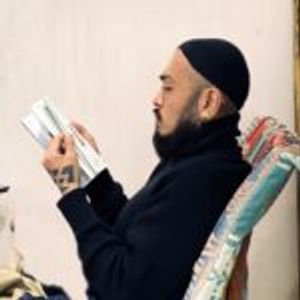“Graffiti is action itself.” Without a hint of pretension, KAZZROCK uttered those words on the second floor of BLOCK HOUSE. We were waiting at HARUKAITO by island for the arrival of SNIPE1, who contacted us right before to let us know he would be a bit late. There was no hesitation in his voice. No pause as he delivered his words. Perhaps it’s proof that none of the words he delivers are borrowed. Ever since the late ‘80s, when he stood before a blank wall in Tokyo holding a spray can in one hand, he’s been a living witness who independently pioneered Tokyo’s street art and led the scene. As a member of CBS, one of the craziest graffiti crews from America’s West Coast, he was the first person in Japan to have a solo graffiti exhibition. The people following in his footsteps often refer to him as a legend. But KAZZROCK himself smiles and says that he doesn’t want to be called such a grandiose name, even if it is an expression of respect. According to him, he’s the same as anyone who just recently started graffiti. And to this day, he’s on the same playing field.
During KAZZROCK’s solo exhibition, GOOD VIBES ONLY!, I visited the venue in BLOCK
HOUSE twice. BLOCKHOUSE, which is located in backstreets a five-minute walk from Meiji-jingumae station, was markedly different from its usual state during those few weeks. There was a sort of nostalgic feeling—that feeling of the ‘90s. That tingling sensation that I felt when I accidentally wandered into the back alleys of Harajuku back then. To tell the truth, the sensation of the street that we no longer feel in today’s Harajuku was certainly in the air around BLOCK HOUSE during those few weeks. At the bottom of the stairs on the first floor, guys with tattooed arms were gathered, skateboards in hand. In the corridor outside the second floor, where the gallery is located, I could see tough-looking guys with tattoos enjoying friendly conversation while smoking. Strangely enough, the fact that the TABOO1 exhibition was open on the fourth floor at the same time may have had a synergistic effect. It was as if BLOCKHOUSE was being occupied by the delinquents of the city, and the entire four-story building had turned into a huge hangout—a street.
At the center of this monkey park (in fact, the exterior of BLOCK HOUSE is somewhat reminiscent of a rocky cliff) that suddenly appeared in the backstreets of Harajuku was none other than KAZZROCK and the traces of aerosol spray that he had streaked onto the canvas. Perhaps the works on display were just an excuse for the men to hang out. Or rather, it seemed as if the fact that they were hanging out in and of itself was a conceptual work of art. (Of course, the exhibited works were without a doubt backed by KAZZROCK’s skills and vibes.) If this imaginary work had a statement, it would be something like this: The street does not summon graffiti; graffiti creates the street. In this sense, the infamous “broken window theory,” a theory that supported cleaning up the city’s landscape, may not be entirely wrong.
For a moment, something happened that made me a bit nervous. SNIPE1 was nowhere to be found, so while we were waiting for him, I interviewed KAZZROCK one-on-one for a bit. Around 45 minutes past our appointment time, KAZZROCK, clearly annoyed and standing up from his seat, said, “I think that’s enough—let’s call it a day. I’m going home.” At that exact moment, SNIPE1 came rushing into HARUKAITO by island. “Sorry, KAZZ-san!” I worried for a moment that there was about to be a confrontation, but KAZZROCK, who had been gazing at the same landscape for over a quarter of a century with SNIPE1, had already broken into a smile when he rebuked, “What the hell, man?”
“There’s no story more interesting than that of the scene in the mid-90s.”
SNIPE1, who is about five years younger than KAZZROCK, is also an active graffiti writer who has been on the scene since its dawn and continues to be at its forefront. Regarding the scene back then, which they are both familiar with, the two look back and say, “It was really wild.” So, what are their thoughts on the scene today, which is rumored to be the “street art bubble?” But honestly, that’s not really what I want to hear from them. I just want to hear them reminisce on old times. What happened back then—in Tokyo and the world? This is a two-part conversation between the two men, who are now “dad friends,” consulting each other from time to time on concerns about their children’s educations.
When the two first met: Tokyo’s graffiti scene in the early ‘90s
──When did you two first meet?
KAZZROCK: Hm, when did we first meet again?
SNIPE1: Around 1993 in Yoyogi Park.
KAZZROCK: Really? I don’t remember that at all. Were you by yourself?
SNIPE1: I was with IZO and others. But you were cold at the time. (laughs)
KAZZROCK: ’93, right? It was a cold time. (laughs) It was right around the time that Tokyo’s graffiti scene, though still small, was starting to gain traction.
SNIPE1: Right. You were a pioneer of Yoyogi Park, so I tried to keep out of that territory. I was at Komazawa Park. And you didn’t go there much either, right?
KAZZROCK: Yeah, I didn’t go there.
SNIPE1: At the time, you already appeared in the media a lot. You stood out. Even though you were in the public eye, you were doing what you had to do, and you didn’t just do legal work, but also illegal work too. I respected that about you. A lot of people stop doing illegal stuff the moment they appear in the media, don’t they?
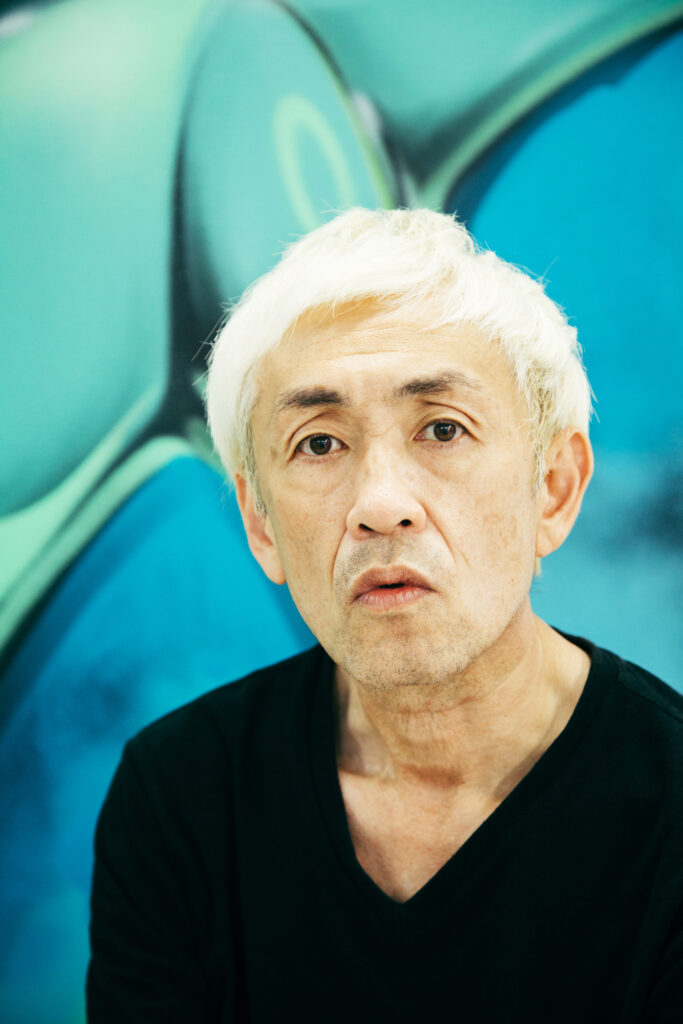
KAZZROCK 
SNIPE1
KAZZROCK: I did that consciously. To be honest, there were times when people would criticize me for making media appearances. But I thought there was no point in keeping everything within a small circle. It would be more interesting if, for example, because I appeared in the media, some kid out in the country might think, “I want to try that too,” right? In fact, I’d been going to Osaka since then, but there was no graffiti there at all, even in Amemura [American Village]. Even if I bombed in the afternoon, no one would say anything to me. At the time, there was hardly any graffiti in the streets of Osaka. The only thing I saw was when XLARGE opened and SLICK came to paint Kikaider. That’s how things were, which is why when the media approached me, I was like, “I’ll give it a go.”
SNIPE1: There are a lot of people in the generation below us who started graffiti because they were inspired by you.
KAZZROCK: But that’s not to say that I wanted to go down the commercial route. I was still doing stuff while being in the media. I thought God would forgive me. (laughs)
SNIPE1: No, he won’t forgive you (laughs)
KAZZROCK: Also, I joined CBS [Editor note: One of LA’s leading graffiti crews] around 1993, and when I’d tell the guys over there that I was in the media, they’d be like, “That’s dope, you did it!” I didn’t have to market myself—the media approached me and gave me publicity, so there was no reason not to do it. But I was getting a lot of hate from people in Japan.
SNIPE1: Really? There wasn’t anyone around me who was dissing you.
KAZZROCK: It’s because in any case, I handled that well while continuing to paint to this day. In the end, I think whoever keeps painting wins. If you quit, it’s all over.
SNIPE1: There are a lot of people who quit even though they said all kinds of stuff.
KAZZROCK: It’s a waste. Even if you quit for a year or two, if you have a love for street art in your heart, you can just come back to it.
SNIPE1: There’s no way you can quit. Once you know that joy, there’s no way to quit.
The LA scene in the early ‘90s and becoming a member of CBS
──KAZZ, what kind of impression did you have of SNIPE in the ‘90s?
KAZZROCK: This isn’t particular to SNIPE, but I wasn’t really aware of other writers, you know?
SNIPE1: (laughs)
KAZZROCK: Although when someone goes over you [Editor note: “going over” is the action of painting on top of another writer’s graffiti], it’s like, “What a pain in the ass—what’s his problem?” SNIPE wasn’t that type.
SNIPE1: I don’t do that.
KAZZROCK: Right. SNIPE has clearly defined his own rules—he draws the line, like, “This is fine, but I don’t do that.”
SNIPE1: But I do remember you once gave me a warning back then.
KAZZROCK: What are you talking about? I don’t remember that.
SNIPE1: When I was painting in Harajuku, I once bombed [Editor’s note: To graffiti on the street] your acquaintance’s store.
KAZZROCK: Oh, around Urahara, right? Back when that area was still dull.
SNIPE1: Yeah. You were like, “Leave that store alone.”
KAZZROCK: I guess that happened, huh. Well, we used to hang out around there with all kinds of people back then.
SNIPE1: But I have a strong impression that you worked solo. I think people respect that about you. Because I totally attack with numbers.
KAZZROCK: I was basically solo. It’s much faster that way.
SNIPE1: That’s true. But VANGUARD [Editor note: An organization founded by KAZZROCK in the early ‘90s that was involved in a variety of activities in the street scene, including graffiti and hip hop] had a lot of people.
KAZZROCK: At one point, VANGUARD had grown to around 150 people. There were all kinds of people— dancers, DJs, and skateboarders—but everyone loved graffiti. With those friends, I was always the one who took the initiative to paint. Wow, that takes me back.
SNIPE1: I tricked locals into carrying spray cans and dragged them into graffiti. And as we were hanging out at Komazawa Park, another group doing graffiti came up to us. We basically always rolled with about 20 people. We’d go on expeditions to Ueno or Asakusa, beat up a neighborhood in a single night, and go home.
──You both went to the US in the early ‘90s, right?
KAZZROCK: I used to go to LA a lot from ‘90-92. I went intermittently after that too. Plus, I joined CBS in ’93.
SNIPE1: It was the best time in LA, wasn’t it?
KAZZROCK: Yeah, it was a time when RISK (Kelly “RISK” Graval), SLICK, and HEX were painting like crazy, and Mr. Cartoon was really active in LA. There were the Los Angeles riots, too.
SNIPE1: There was also the Zero [One] Gallery [Editor note: 01 Gallery, an art gallery that made a big contribution to the street art scene], right? And there was the AM7 crew. I painted with those guys.
KAZZROCK: That crew was like CBS’s little brother, right? Wow, that brings back memories.
SNIPE1: A group of Europeans got together and formed AM7 because they couldn’t join CBS. They were great guys, and we got along right away because I was also an outsider. CBS painted on the front streets of Melrose, so we painted on the backstreets.
KAZZROCK: Because CBS is based in Midtown. Actually, Mear (Mear One) lived in an apartment on the corner of Melrose and Fairfax, and I used to go there all the time.
SNIPE1: There’s a high school there, right? There was a tunnel underneath that. I’ve painted in that tunnel before. I respect Mear a lot—he’s so cool.
SNIPE1’s experience of the NY graffiti scene
──SNIPE, you were living in NY at the time, right?
SNIPE1: Yeah. From around ’90 to ’93.
KAZZROCK: You can tell that he was in New York from looking at his style, right? His lettering has that NY style. Although of course, he has his own style, too. In that respect, I’m LA-style. That’s why I like characters more than lettering. California is more about characters than letters.
SNIPE1: Bronx kids (BEP, BRT, NSV) taught me all kinds of things about tags [Editor’s note: A graffiti writer’s signature] and throw-ups [Editor’s note: Drawing letter outlines in one or two colors]. To this day, I still talk to the guys from that crew.
KAZZROCK: You painted cool masterpieces, too.
SNIPE1: Wow, I didn’t think you’d say that. (laughs)
──So in NY at the time, did you go to the Alleged Gallery [Editor’s note: An art gallery that featured a lot of street art from its establishment in 1992 to its closing in 2002]?
SNIPE1: No, I didn’t. I was honestly just hanging out with kids from the hood. It wasn’t like writers were doing things in galleries then. But I went to the opening of Alife! It was around 2000, I think. There were fights all over the place. (laughs)
KAZZROCK: That’s true. It wasn’t a time where graffiti writers were doing exhibitions yet.
SNIPE1: I think there was the concept of street art, but it wasn’t pop like it is now. It probably changed after Twist (Barry McGee) and KAWS started to move towards art.
KAZZROCK: It was around 2000, wasn’t it? Actually, I did an exhibition at a gallery in ’95.
SNIPE1: What?!
KAZZROCK: It was a solo exhibition called Graffiti Art is Not a Crime.
SNIPE1: You were early. Oh, but there was also the Graffiti Expo 96 at the time, wasn’t there?
KAZZROCK: I also remember doing a discussion in Shimo-takaido.
SNIPE1: Oh, you were there too?
KAZZROCK: I was invited. I went with some people from my crew and my dog (Bulldog). We were supposed to line up on the stage and have a discussion. But even there, I was attacked. They said graffiti was vandalism, shady, and so on.
SNIPE1: I was rapping with YOU (YOU THE ROCK) there. (laughs) But I feel like at the root of the criticism you receive, there’s jealousy. For example, Mear isn’t the type to bomb that much, but even bombers can respect him. I don’t think it’s right to say that bombing is the only kind of graffiti.
KAZZROCK: If you only bomb, it’s hard to keep it going. If you want to make a living and dedicate your life to it, there’s also an aspect where you might need to think about what’s next. It’s not just about making money though. It’s also about how you can make time for art within your daily life. I’ve always thought a lot about those things. Because I always wondered why I was doing part-time jobs when I just wanted to use that time to paint.
SNIPE1: I get it. Well, if all you do is complain about other people, karma will make its way back to you. People who say bad things will end up having bad things said about them.
KAZZROCK: In any case, there was a lot of conflict back then.
SNIPE1: A lot happened. (laughs) You were pretty wild at the time.
KAZZROCK: I’m really nice now, right?
SNIPE1: You’re the best. Because you’re a graffiti senpai, and also a life senpai. (laughs)
※Continues to the last half part 2
*
KAZZROCK
KAZZROCK is a graffiti writer/artist from Tokyo. In the early ‘90s, he founded VANGUARD, an organization dedicated to various activities within the street scene, including graffiti and hip hop. Later, he moved by himself to the US to hone his skills and joined the Los Angeles graffiti crew CBS, becoming the only Japanese member. After returning to Japan, he continued with street art while also doing solo exhibitions, making CD jackets and artwork, and designing things for manufacturers. In 1998, he started his own apparel brand, KAZZROC ORIGINAL, and in the following year, he established his own company, VANGUARD. In 2005, he became the main sponsor of the All Japan Road Race Championship in the ST600 class, designing the racing suit and helmet under the name KAZZROCK RACING. In 2015, he had an exhibition in Hong Kong, and in 2019, he had exhibitions in Taiwan (in 10 locations including Taipei, Taichung, Tainan, and Kaohsiung). Today, he continues to be active in a variety of fields both at home and abroad.
Instagram:@kazzrock_cbs
Twitter:@kroriginal
SNIPE1
SNIPE1 is a graffiti writer and artist. As a teenager in the early ‘90s, he threw himself into the NY graffiti scene. After exploring the graffiti community across the world and creating connections, he returned to Japan. Since moving his base to Japan, he has contributed to the rise of graffiti culture in Japan in many ways. In 2018, he held his first solo exhibition at Takashi Murakami’s Hidari Zingaro gallery, winning acclaim. To this day, he’s still bombing the art world through avant-garde galleries around the world, including in LA, NY, Bangkok, Hong Kong, and Melbourne.
Instagram:@fukitalltokyo
Photography Ryosuke Kikuchi
Special Thanks HARUKAITO by island
Translation Aya Apton


